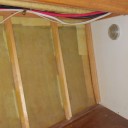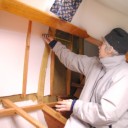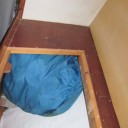Remodeling the V Berth
February 1st, 2010 | by Marilyn | Published in Upgrades | 1 Comment
Here’s a great project that we think will really make a difference to our cruising enjoyment.
It all started with our efforts to figure out where to install a waste holding tank. Typically, people stuff them under a V berth in the forward cabin. In the as-built Nic 38, the storage under the V berth is only accessible via a way-too-small door in the vertical support under the berth. The horizontal boards under the berth were all screwed down. No problem, we thought. We’ll just remove the screws and lift off the board. Well, it turns out that the whole V berth was put together like a jigsaw puzzle. To get to all the screws for those berth boards, you had to remove the wall board. But to remove the wall board, you had to remove the ceiling board that encloses the electrical wire run. Next thing we knew, we had nearly the whole forward cabin torn apart! So, we decided might as well remodel it.
First, Captain Van wanted to insulate the hull. So we bought some 1.5” Styrofoam insulation boards, cut them to size to fit between the existing wood “studs” along the hull, and stuffed them in. This took some careful measuring, but we did a good job and they are a nice press fit. We just hope they don’t squeak a lot as the boat sails along. We’ll find out once we get some decent sailing weather.
Second, we made new wall boards out of some birch plywood we had leftover in the garage. The original walls were white vinyl wallpaper, and they were looking a little dull. The nicely varnished birch plywood really sharpened up the appearance of the cabin.
And finally, we decided not to use the storage area for the holding tank after all. Its just too nice (and we came up with a much more clever place for the holding tank – but that’s yet another story that needs to be posted). Much better to use that space for sail storage, we thought. So we went about designing how we could have access lids under the berths that would be strong enough for our weight when we are sitting/sleeping on the berth, yet large enough to shove in a sail bag. We essentially kept the supports that were there, beefing them up a bit, and cutting an access door between the outer supports. This sliced the mid-support in half, but we figured out how to strengthen that too. We also painted in the hull inside of the lockers because it was rather black and grungy looking, as most hulls are on older boats. So now, we have very nice access to clean lockers that are each big enough to hold at least one sail bag, as the pictures below show. Getting the spare sailbags out of the way is really, really nice. We were getting sick of them being in the way in the aft cabin, which is where we previously had them stored. And now, if we want to, we can hand them up to the deck through the foward cabin hatch – just the way the designers had planned.
Looking at the photos we have of this, its just very hard to get a perspective on how nice this turned out. I guess if you really want to know, you’ll have to come see for yourself.
- Once we took out the ceiling and wall boards, we could see how the builders had already added wood studs. That made installing insulation lots easier.
- Marilyn is carefully measuring the separation between the studs, so Van can cut the material to insulation size.
- Here is the gennicker sailbag shoved aft in the port side locker, leaving enough space in the locker that we could put in the jib too.
- Capt’n Van looks pretty pleased with how this turned out.




March 4th, 2010at 12:03 pm(#)
This message in response to an earlier enquiry.
G’day , I had to replace my holding tank a couple of years ago, in La
Paz, Baha of all places but was pleasantly surprised that a s/s tank only
cost US$125.00 not bad when Mexicans associate all cruisers as rich
Americans.
Assuming that you have an aft head the tank neatly fills out the outboard
space in the port side cockpit locker still leaving at least 1/2 the locker
space still available.
That leaves all associated piping short and through 1 bulkhead only. There
is a ‘y’ valve and a diaphragm hand pump in the enclosed head locker
connected directly to the original through hull fitting exit . So– I can
either pump directly overboard or divert into the holding tank. To empty the
tank I can pump overboard using the hand pump or empty using shore facility
through a deck fitting piped directly to the tank. rgds-Roger.